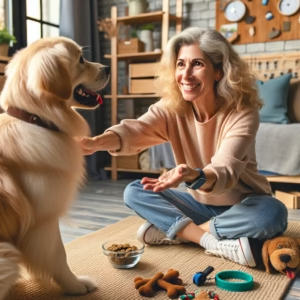So, dogs and separation anxiety, two words that have been causing quite a stir in pet parent circles.
But why?
Well, think about it. Your furry best friend is like this amazing companion, able to bring joy and comfort without asking for much in return.
Pretty wonderful, right?
However, there’s a question that hovers around many dog households: “Why does my dog freak out when I leave?”
Some think, “They’re just being dramatic!”
Others believe, “Something’s seriously wrong here.”
And then there are the pet parents, looking for real answers, practical solutions, actual results.
And guess what? There are 7 reasons dogs develop separation anxiety that can help explain why your couch cushions end up looking like a crime scene every time you grab your car keys.
But how? Why?
We’re about to unravel the mystery.
What Is Separation Anxiety in Dogs?
Here’s the deal.
Separation anxiety isn’t just your dog being “clingy” or “spoiled.” We’re talking about genuine, heart-racing, panic-inducing terror when their favorite humans walk out the door.
Think of it like this, imagine if every time your best friend left the room, you genuinely believed they might never come back. That’s what some dogs experience, except it can last for hours and involves a lot more destruction than human anxiety typically does.
But what does this really look like?
To simplify, separation anxiety is like that overwhelming fear you might feel in a crowded place, except for dogs, it’s triggered by being alone.
The condition shows up differently in each pup, but the core emotion is consistent: genuine terror at being left behind.
The Science Behind Canine Attachment
Dogs are pack animals by nature. When we bring them into our homes, we essentially become their pack, and for some dogs, this attachment becomes so intense that our absence triggers their deepest survival fears.
Recent research has revealed something fascinating – separation anxiety actually involves different emotional states including fear, panic, and frustration. This explains why two dogs with separation anxiety might act completely differently. One might bark like they’re announcing the apocalypse, while another becomes laser-focused on escaping through the nearest window.
Common Signs You Shouldn’t Ignore
The symptoms typically show up within minutes of your departure. We’re talking excessive barking (the neighbors will let you know about this one), destructive chewing that would make a beaver jealous, house soiling despite perfect potty training, pacing like they’re training for a marathon, and in severe cases, self-harm.
What’s particularly telling? These behaviors only happen when the dog is alone. They’re perfect angels when you’re home.
The 7 Primary Reasons Dogs Develop Separation Anxiety
1. Sudden Changes in Daily Routine
Schedule disruptions are probably the biggest culprit here.
Dogs thrive on predictability. When their world suddenly becomes unpredictable? Anxiety often follows like an unwelcome shadow.
Work-from-Home to Office Transitions
The pandemic created a perfect storm for this. Millions of dogs got used to having their humans home 24/7, only to face abrupt schedule changes when offices reopened.
Picture this: Your dog spent two years thinking you’d finally figured out that home is where you belong. Then suddenly, you’re gone for eight hours a day. From their perspective, something has gone terribly wrong with the world order.
Schedule Disruptions and Their Impact
Even smaller changes can trigger anxiety in sensitive dogs. Starting a new exercise routine, changing feeding times, or switching from morning to evening walks can destabilize a dog’s sense of security.
Dogs are creatures of habit. When those habits get disrupted without gradual adjustment? Anxiety can emerge faster than you can say “separation anxiety.”
2. Moving to a New Home
Relocation stress is a major trigger that many people don’t see coming.
Moving to a new place can trigger separation anxiety because dogs lose their familiar territory and established safe spaces.
Environmental Stress Factors
New homes come with unfamiliar sounds, smells, and layouts. A dog who was perfectly chill being alone in their previous home might suddenly feel vulnerable in new surroundings.
Think about it, they’ve lost all their familiar scent markers and established “safe zones.” Being alone in an unfamiliar place can feel exponentially more threatening.
Territory and Security Concerns
Dogs create mental maps of their territory, including escape routes and hiding spots. In a new environment, they haven’t had time to establish these security measures.
It’s like being asked to relax in a house you’ve never been to before, except you can’t ask where the bathroom is or when someone will be back.
3. Changes in Household Composition
Family dynamics play a huge role in canine emotional stability.
The sudden absence of a family member, whether due to death, divorce, or kids going off to college, can trigger separation anxiety development.
Loss of Family Members
When a family member dies or moves away, dogs don’t just miss that person. They experience a fundamental shift in their pack structure.
If the departed family member was a primary caregiver or provided specific comfort during alone time, their absence can leave an emotional void that manifests as separation anxiety.
New Additions to the Family
Conversely, new family members can also trigger separation anxiety. Whether it’s a new baby, a partner moving in, or additional pets, the dog’s established relationship with their primary attachment figure might feel threatened.
This leads to increased clinginess and distress when that person leaves. It’s like suddenly having to share your best friend with someone else.
4. Genetic Predisposition and Temperament
Inherited traits play a bigger role than most people realize.
Dogs born to anxious parents are more likely to suffer from anxiety disorders. There’s a strong genetic component to this condition that we’re only beginning to understand.
Inherited Anxiety Traits
Just like humans can inherit tendencies toward anxiety, dogs can be born with nervous systems that are more reactive to stress.
These dogs might be generally more sensitive to environmental changes, loud noises, or social disruptions. They’re essentially born with a more sensitive alarm system.
Breed-Specific Vulnerabilities
While any dog can develop separation anxiety, certain breeds with strong attachment tendencies might be more predisposed.
German Shepherds, Labrador Retrievers, and Border Collies, for example, were bred for close human partnership. Sometimes that intense bonding can become problematic when broken, even temporarily.
5. Early Life Experiences and Trauma
Developmental experiences during puppyhood significantly influence adult anxiety levels.
Being left alone for the first time or experiencing traumatic events can create lasting associations between solitude and danger.
Puppy Socialization Gaps
Puppies who aren’t gradually exposed to being alone during their critical socialization period (roughly 3-14 weeks) may never develop confidence to handle solitude.
This is particularly common in puppies who were constantly with their littermates or human families without any alone-time practice. They never learned that being alone is normal and safe.
Rescue Dog Backgrounds
Dogs with unknown histories or those who experienced abandonment, neglect, or multiple rehoming situations often carry emotional baggage.
Their past experiences have taught them that being alone might mean being abandoned permanently. Can you blame them for panicking?
6. Lack of Mental and Physical Stimulation
Understimulation can masquerade as separation anxiety or make genuine anxiety symptoms worse.
Frustration or boredom from lack of enrichment activities, adequate exercise, or mental challenges can contribute to destructive behaviors that look exactly like separation anxiety.
Boredom vs. True Anxiety
It’s crucial to distinguish between a bored dog acting out and a genuinely anxious dog experiencing distress.
Bored dogs might be destructive, but they typically don’t show the physiological signs of anxiety like trembling, excessive drooling, or panic-driven behaviors.
Exercise and Enrichment Needs
High-energy breeds or intelligent dogs who don’t get adequate physical exercise and mental stimulation may develop anxiety-like behaviors simply because they have excess energy and no appropriate outlet.
A tired dog is generally a calmer dog. Sometimes meeting their exercise needs can resolve what appears to be separation anxiety.
7. Owner Behavior and Attachment Patterns
Human behavior significantly influences whether dogs develop healthy independence or problematic attachment.
The attitude and actions of pet parents can contribute to separation anxiety development, often without realizing it.
Reinforcing Anxious Behaviors
Well-meaning owners often accidentally reinforce separation anxiety by providing comfort when their dog shows distress about their departure.
Making a big fuss over leaving or returning, or giving attention to whining and clingy behavior, can actually strengthen these unwanted responses. It’s like accidentally teaching them that being upset gets them attention.
Creating Healthy Independence
Dogs need to learn that being alone is normal and safe. Owners who never leave their dogs alone, even for short periods, may inadvertently create dogs who are incapable of handling solitude.
Healthy attachment includes the ability to be apart without distress. It’s about balance, not constant togetherness.
The Emotional Science: Fear vs. Frustration vs. Panic
Understanding the emotional underpinnings of separation anxiety helps explain why different dogs show different symptoms.
Research has identified that dogs can react to owner absence due to different inner states: fear, panic, or frustration.
Understanding Different Anxiety Triggers
Fear-related separation anxiety typically shows up as whining and general signs of distress. Frustration-driven anxiety leads to barking and destructive behaviors focused on doors or windows.
Dogs prone to phobic reactions tend to show more escape-oriented behaviors and intense panic responses. It’s like having three different types of alarm systems that all sound different.
How Dogs Process Separation
The emotional experience isn’t static, dogs may cycle through different emotional states during a single episode.
They might start with frustration (barking, scratching at doors), escalate to fear (whining, pacing), and potentially reach panic levels (destructive escape attempts, self-harm) if the separation continues.
Prevention Strategies That Actually Work
Proactive prevention is always easier than treating established separation anxiety.
The key is building confidence and positive associations with alone time from an early age.
Building Confidence Early
Start with very short separations, even just stepping outside for 30 seconds, and gradually increase duration as the dog remains calm.
Practice departure cues (picking up keys, putting on shoes) without actually leaving to desensitize dogs to these triggers. It’s like exposure therapy, but for dogs.
Creating Positive Alone-Time Associations
Make being alone rewarding by providing special toys, puzzle feeders, or treats that only appear when the dog is alone.
This helps shift the emotional association from “alone time = abandonment” to “alone time = good things happen.” Pretty clever, right?
When to Seek Professional Help
Professional intervention becomes necessary when separation anxiety significantly impacts the dog’s quality of life or causes property damage, neighbor complaints, or family stress.
Veterinary Behaviorist Consultation
Diagnosing separation anxiety involves a comprehensive evaluation of the dog’s history, behavior patterns, and environmental factors.
Board-certified veterinary behaviorists can distinguish between true separation anxiety and other conditions that might present similarly.
Treatment Options and Success Rates
Treatment typically involves a combination of behavior modification, environmental management, and sometimes anti-anxiety medication.
Success rates are generally high when owners commit to consistent training protocols, though progress can take weeks or months depending on severity.
But remember, while professional help is powerful, it’s not magic. A blend of professional guidance with consistent home practice can work wonders.
The journey through separation anxiety isn’t always linear, there will be good days and setbacks. But understanding these seven core reasons gives us a roadmap for both prevention and treatment.
Remember, your dog isn’t trying to punish you for leaving. They’re genuinely struggling with emotions they can’t control or understand.
Every dog deserves to feel secure and confident, whether their humans are home or away. By recognizing these triggers and addressing them proactively, we can help our canine companions develop the emotional resilience they need to handle life’s inevitable separations with grace rather than panic.
DOG PARENT TIP: If you’re dealing with separation anxiety, always start with small steps and be patient. Think of yourself as your dog’s emotional coach. You’re teaching them that being alone is safe, not scary. And remember, consistency is key, sporadic training is like trying to learn a language by only practicing once a month!
Frequently Asked Questions
Can separation anxiety develop suddenly in older dogs?
Yes, absolutely! Separation anxiety can develop at any age. Older dogs may actually be more susceptible due to cognitive changes, health issues, or decreased ability to cope with environmental changes. Senior dogs who’ve never shown separation anxiety can develop it following major life changes or the onset of age-related anxiety disorders.
Is separation anxiety more common in rescue dogs than dogs raised from puppies?
While rescue dogs may have higher rates due to previous traumatic experiences or multiple rehoming situations, any dog can develop this condition. The key factors are individual temperament, early socialization experiences, and current environmental stressors rather than simply rescue status.
How long does it typically take to treat separation anxiety in dogs?
Treatment timelines vary significantly depending on severity and consistency of the training program. Mild cases might see improvement in 2-4 weeks, while severe cases can take several months of dedicated behavior modification. The key is patience and consistency with the treatment protocol.
Can multiple dogs in the same household develop separation anxiety together?
Yes, separation anxiety can sometimes spread between dogs in the same household, particularly if one dog’s anxious behaviors trigger stress in others. However, having a calm, confident dog can also help an anxious dog feel more secure when left alone, so the dynamic can work both ways.
Are there specific breeds that are more prone to developing separation anxiety?
While any breed can develop separation anxiety, dogs bred for close human companionship (like toy breeds, herding dogs, and some sporting breeds) may be more predisposed. However, individual temperament and life experiences are more predictive than breed alone.
Resources:
- https://www.nature.com/articles/s41598-021-98526-3
- https://avmajournals.avma.org/downloadpdf/journals/javma/219/4/javma.2001.219.460.pdf






